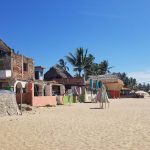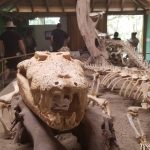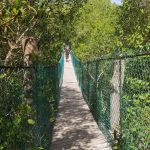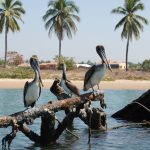Blog day 8- Group 3
After celebrating the first night of the Carnaval in Autlán, we woke up early for complimentary breakfast and packed our bags for the next part of our adventure. We set off at 9 am and began for Chamela, first stopping at a beachfront town called Melaque. Along the drive, we noticed a drastic change in vegetation as we moved closer to the coast. The trees became shorter and thinner in stature, and palm trees and cactus began to dominate the landscape. We parked by the beach and headed down to enjoy a swim in the Pacific Ocean where we greeted by diving brown pelicans (Pelacanus occidentalis), double crested cormorants (Phalacrocorax auritus), common tern (Sterna hirundo), magnificent frigatebirds (Fregata magnificens), and beach venders selling souvenirs. After a very delightful swim and candid photoshoot, we enjoyed a delicious lunch on the beach along with some much-needed cold beverages. We took this opportunity to walk through the streets, talking to locals and testing the large variety of banana species this area has to offer. We did our best to dust off the sand before heading to another small beach town called Manzanilla. Manzanilla hosts a natural mangrove estuary, home to many American crocodiles (Crocodyls acutus)and other species that occupy these brackish waters. Freshwater inlets coming in from higher elevations collide with the salty waters of the Pacific Ocean to create wetlands where Mangrove trees dominate. These trees have unique physiological abilities in order to survive in saline waters where many other plants cannot survive. Here we saw another collection of bird species, such as the great egret (Ardea alba), yellow crowned night heron (Nyctanassa violacea), and great-tailed grackles (Quiscalus mexicanus). We also had the opportunity to hold a baby crocodile (with supervision of course)! Darcy then gave a short presentation on the American Crocodile, noting that these animals have multiple eyelids for hunting underwater, and nostrils that can close in order to remain submerged for long periods of time. After completing the mangrove walk, we grabbed some snacks to fuel us for the week ahead before departing to the Chamela field station. Upon arriving we were delighted with the brightly coloured facilities of the field station that would be our home for the next week. We quickly ran to our rooms to unpack, and began to notice the flora and fauna of this dry forest which had been damaged in years prior during a hurricane. We were immediately greeted by coatis geckos, flocks of parrots, a tarantula (YIKES), a pair of hawks, and armies of army ants. The views of the mountain range and forests surrounding the field station will be something to look forward to every day of our stay. We continued investigating until dinner-time, where we enjoyed a Sunday night dinner of delicious tacos in the cafeteria. After dinner, we headed to the air-conditioned auditorium for the rest of the night to attempt to do some homework and update our families on our adventures as the geckos clicked in the ceiling. We can’t wait to venture around this beautiful station.
En Español
Día 8 – equipo 3
Después de celebrar la primera noche de carnaval en Autlán, nos levantamos temprano a desayunar y empacar para continuar con nuestra siguiente Aventura. Saliendo con rumbo a Chamela a las 9am con el plan de visitar primero un pueblo en la playa llamado Melaque. Los árboles de la zona son más cortos y delgados y se comenzaron a ver palmeras y cactus dominando el paisaje. Una vez que llegamos a la playa, nos fuimos todo el grupo a disfrutar y nadar en el Océano pacífico donde nos dieron la bienvenida un buen número de pelícanos (Pelecanus occidentalis), Cormoranes (Phalacrocorax auratus) Charranes (Sterna hirundo) y Fragatas (Fragata magnificens), ademas de un buen número de vendedores de artesanías en la playa. Después de una rica nadada y sesión de fotos, nos fuimos a comer una deliciosa comida en la playa con unas muy necesitadas bebidas frías. Después nos aventuramos a caminar por las calles del pueblo para conocer la gente y aprovechar para probar todas las variedades de plátanos que encontramos en el pueblo. Hicimos lo mejor posible para sacudirnos la arena antes de irnos a otra playa cercana llamada La Manzanilla donde hay un estero y manglar, hogar de numerosos cocodrilos (Crocodylus acutus) y otras especies que habitan estas aguas salobres. Agua dulce que baja de las montañas, se encuentra con las aguas del océano pacífico para crear aguas salobres donde dominan los manglares. Los árboles tienen habilidades fisiológicas únicas para sobrevivir las condiciones Salinas que otras plantas no pueden soportar. Observamos además otro buen número de especies d aves, incluyendo la Garza nocturna de Cabeza amarilla (Nyctanassa violacea), Zanates (Quiscalus mexicanus) y garzones blancos (Ardea alba). Más Adelante, tuvimos oportunidad de tomar cocodrilos en nuestras manos (supervisados claro está)! Darcy nos habló también sobre las características de los cocodrilos, enfatizando en que estos animales tienen varias adaptaciones para cazar bajo el agua como los nostrilos que se cierran para permanecer mucho tiempo bajo el agua. Después de que terminó nuestra caminata por el manglar, nos fuimos a comprar botanas para tener reservas en nuestro viaja hacia la estación científica de Chamela. A nuestra llegada, nos alegramos de ver los encendidos colores de los edificios que serían nuestro hogar la siguiente semana. Rápidamente nos instalamos en nuestros cuartos y empezamos a observar la característica flora y fauna del lugar de este bosque seco dañado recientemente por un huracán. Nos dieron la bienvenida los Coatis, Geckos, loros y tarantulas (Hayyyy!) un par de Gavilanes y ejércitos de hormigas.
La vista de las montañas y el bosque alrededor de la estación es algo que nos llama a la aventura en los próximos días de nuestra estancia en Chamela. Continuamos investigando los alrededores hasta la hora de la cena, donde nos ofrecieron deliciosos tacos. Después de cenar, nos fuimos al salón de clases con aire acondicionado por el resto de la noche para intentar hacer algún trabajo y tareas y poner al corriente a nuestras familias de nuestras aventuras mientras los Geckos llamaban desde el techo. Estamos ansiosos por iniciar un nuevo día para aventurarnos en este magnifico lugar.
- Egret in Manzanilla
- Dry forest at Chamela
- Chamela sunset
- Melanie beach
- Yellow-crowned night-heron
- Evelyn with tour wo year old crocodile
- Crocodile museum
- Suberged crocodile
- Suspension bridge over river
- Some basking crocs
- Pelicans












Leave a Reply